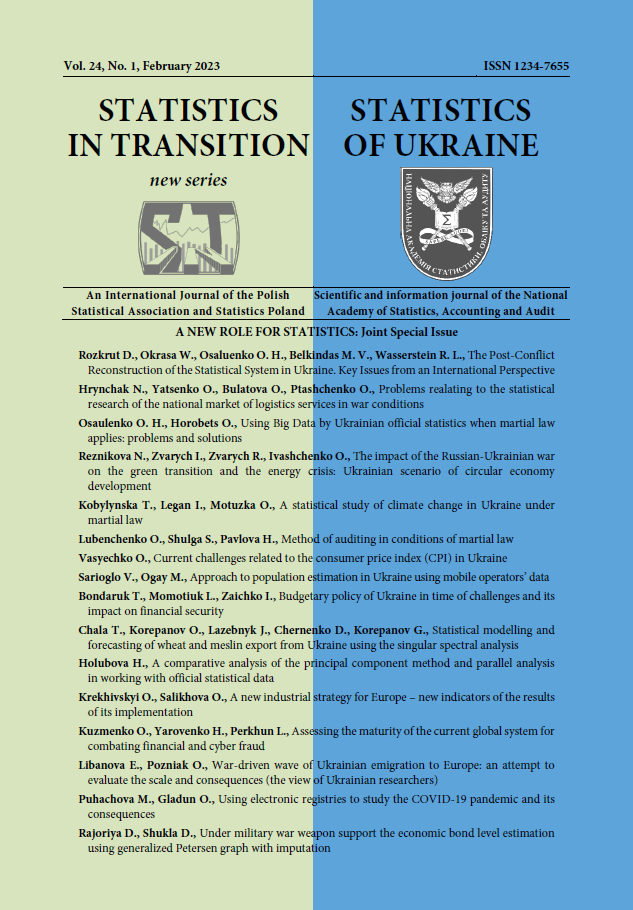ARTICLE
ABSTRACT
Estimating the size and places of residence of the population of Ukraine has been this country’s problem for the past decade, and is related to the lack of census data for the 2010 round, large-scale processes of external and internal labour migration, and Russia's armed aggression against Ukraine that started in 2014. This already disadvantageous situation has been significantly exacerbated by Russia’s full-scale war against Ukraine which began on 24th February 2022. Conducting statistical surveys, especially surveys regarding the population, turned out to impossible under war circumstances. Therefore, the task of developing effective approaches to estimating the population size using data from existing sources, in particular the data of mobile operators regarding the number, location and mobility of subscribers, has become even more pressing. The article highlights the results of a study on the use of data from mobile operators, data from administrative registers, and the results of a special population sample survey on the use of mobile communication for the purpose of estimating the population. It also provides the results of experimental calculations of the population size in Ukraine as a whole and in particular regions. The study moreover showed that the size of Ukraine’s population in November 2019, unlike the official estimate of 41,940.7 thousand people, was probably about 37,289.4 thousand people. The developed approaches can be used to estimate the number and location of the population of Ukraine during the intercensal period or significant population movements due to environmental disasters or military conflicts.
KEYWORDS
population estimation, mobile operators, mobile subscribers, administrative data, sample survey.
JEL
C82, C83, J10
REFERENCES
Handbook on the use of Mobile Phone data for Official Statistics, (2019). UN Global Working Group on Big Data for Official Statistics, September 2019. Retrieved from: https://unstats.un.org/bigdata/taskteams/mobilephone/MPD%20Handbook%202 0191004.pdf.
Lyuds'kyy rozvytok v Ukrayini. Otsinka ta prohnoz rivnya zhyttya naselennya: kol. monohr/NAN Ukrayiny, In-t demohrafiyi ta sotsial'nykh doslidzhen' imeni M. V., (2019). Ptukhy — Kyiv, 270 p [in Ukrainian].
Sarioglo, V., Dubilet, D., Verner, I., (2020). Otsinka chysel'nosti nayavnoho naselennya Ukrayiny. Prezentatsiya, Kyiv,. Retrieved from: https://buhgalter.com.ua/upload/news/2020/??????_????????_?????????_??? ????.pdf [in Ukrainian].
Deville P., Linarde, C., Martine, S., Gilbert, M., Stevens, F. R., & Gaughan, A. E., (2014). Dynamic population mapping using mobile phone data. Proceedings of the National Academy of Sciences, 111(45), pp. 15888–15893. DOI: 10.1073/pnas.1408439111.
Järv, O., Ahas, R., Saluveer, E., Derudder, B. and Witlox, F., (2012). Mobile phones in a traffic flow: A geographical perspective to evening rush hour traffic analysis using call detail records. PLoS One, 7 (11), e49171. Retrieved from: https://doi.org/10.1371/journal.pone.0049171.
Ratti, C, Pulselli, R. M., Williams, S. and Frenchman, D., (2006). Mobile landscapes: Using location data from cell phones for urban analysis. Environment and Planning B: Planning and Design, 33(5), pp. 727–748. DOI:10.1068/b32047.
Reades, J., Calabrese, F. and Ratti, C., (2009). Eigenplaces: Analysing cities using the space-time structure of the mobile phone network. Environment and Planning B: Planning and Design, 36(5), pp. 824–836. Retrieved from: https://doi.org/10.1068/b34133t.
De Meersman, F., Seynaeve, G., Debusschere, M., Lusyne, P., Dewitte, P., Baeyens, Y., (2016). Assessing the Quality of Mobile Phone Data as a Source of Statistics. European Conference on Quality in Official Statistics (Q2016). Madrid, 31 May – 3 June 2016. Retrieved from: https://ec.europa.eu/eurostat/cros/system/files/assessing_the_quality_of_mobile_ phone_data_as_a_source_of_statistics_q2016.pdf.
Lu, H., Frauendorfer, D., Rabbi, M., Mast, M., (2012). StressSense: Detecting stress in unconstrained acoustic environments using smartphones. UbiComp'12.ACM Conference on Ubiquitous Computing, Pittsburgh, 5–8 September, pp. 351–360. DOI:10.1145/2370216.2370270.
